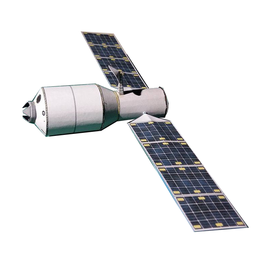Tianzhou 1
2017 Chinese resupply spaceflight to Tiangong-2 From Wikipedia, the free encyclopedia
Tianzhou 1 (Chinese: 天舟一号) was the debut mission of the Tianzhou-class uncrewed cargo spacecraft. It was developed as part of the crewed space program of China. Tianzhou means "heavenly vessel" in Chinese.[1] On 20 April 2017, Tianzhou 1 was launched by rocket Long March 7 at China Wenchang Spacecraft Launch Site. It successfully docked with the Tiangong-2 space laboratory on 22 April 2017 at 12:16 (UTC+8).[2] Tianzhou 1 was deorbited on 22 September 2017. It plunged into Earth's atmosphere and burned up after a set of braking maneuvers under ground control.[3]
 A 1:144 scale Tianzhou-1 model | |
| Mission type | Tiangong-2 resupply |
|---|---|
| Operator | CNSA |
| COSPAR ID | 2017-021A |
| SATCAT no. | 42684 |
| Mission duration | 154 days and 22 hours |
| Spacecraft properties | |
| Spacecraft | Tianzhou-1 |
| Spacecraft type | Tianzhou |
| Launch mass | Under 13,000 kg (29,000 lb) |
| Dimensions | 9 m × 3.35 m (29.5 ft × 11.0 ft) |
| Start of mission | |
| Launch date | 20 April 2017, 19:41 (UTC+8) |
| Rocket | Long March 7 |
| Launch site | Wenchang LC-2 |
| End of mission | |
| Disposal | deorbited |
| Destroyed | 22 September 2017 |
| Docking with Tiangong-2 | |
| Docking port | Fore |
| ing date | 22 April 2017, 04:23 UTC |
| Uning date | 19 June 2017, 01:37 UTC |
| Time docked | 57 days, 21 hours and 14 minutes |
| Docking with Tiangong-2 | |
| Docking port | Fore |
| Docking date | 19 June 2017, 06:55 UTC |
| Undocking date | 21 June 2017, 01:16 UTC |
| Time docked | 1 day, 18 hours and 21 minutes |
| Docking with Tiangong-2 | |
| Docking port | Fore |
| Docking date | 12 September 2017, 15:58 UTC |
| Undocking date | 17 September 2017, 08:15 UTC |
| Time docked | 4 days, 16 hours and 17 minutes |
Spacecraft
It used the first flight model of the Tianzhou. It is a Chinese automated cargo spacecraft developed from the Tiangong-1 to resupply its future modular space station.
Launch
Tianzhou 1 launched successfully on 20 April 2017 at 7:41 pm local time, from the Wenchang space center. This marked the second time a Long March 7 had been used and the first time for a mission. Tianzhou-1 became the heaviest Chinese spacecraft ever launched, at that time.[4]
Mission
This mission demonstrated the Tianzhou spacecraft and its capabilities. It critically demonstrated propellant transfer for the Chinese space station, the last big hurdle for long-duration expeditions.[5] On April 22, 2017, Tianzhou 1 successfully docked with Tiangong 2 marking the first successful docking of a cargo vessel, and refuelling, with the orbiting space laboratory.[6] It subsequently performed a second docking and refueling on June 15, 2017. After it coupled with Tiangong 2 for a period of 60 days, it decoupled and separated from the space laboratory and completed a three-month period of free flight at around 390 kilometres above the Earth, separately carrying out a range of science experiments. On September 12, 2017, Tianzhou 1 performed the third and final docking and refuel with Tiangong 2, with what is termed a fast docking which took 6.5 hours to complete.[7] Previously the rendezvous and docking process took around two days, or 30 orbits.[8]
References
External links
Wikiwand - on
Seamless Wikipedia browsing. On steroids.
